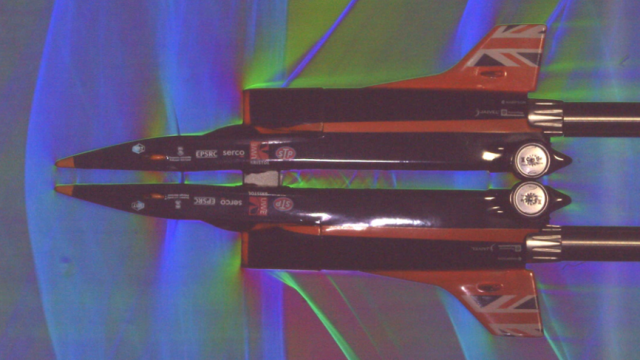When you’re in the process of building a supersonic car, you want to understand how it behaves at speed before you put a driver in it. So how, exactly, do you do that?
There are, in fact, two competing schools of thought. The first, which the developers of Bloodhound SSC are using, is computational modelling. Using computational fluid dynamics software, the team can accurately predict what will happen as their car approaches a dizzying 1000km/h. In turn, they can ensure the car neither takes off nor drives into the ground as it reaches high speeds.
The alternative is to take an experimental approach and use a wind tunnel, as shown in the image above. In fact, the image is taken from a series of recent experiments carried out in Japan and recently tweeted by Dr Ben Evans, an aero engineer working on the Bloodhound project. It’s not been carried out by the team, though it is, obviously, of some interest to them.
I say some because, while it may look like the real thing is being tested, you’re actually looking at two small Bloodhound SSC toys that have been placed in the wind tunnel — so the results are suggestive rather than accurate.
If you’re wondering why there are two cars sandwiched together in the image, it’s to recreate the effects of the ground that the car drives along. For free-flying wind tunnel tests, it’s OK to ignore the ground — because it’s always a long way from the object in question in the real world. Mounting a stationary object and blowing high velocity wind at it accurately mimics the real physical situation.
But for a supersonic car, the effects of air flow across the ground also have to be accounted for. One option is to build a moving road beneath the vehicle, a kind of treadmill — but that’s complex and expensive. The alternative it to mount two models, belly-to-belly. The symmetry of the system means that the flow straight down the middle stagnates, acting like an imaginary ground plane relative to the model.
The other reason that the Bloodhound SSC team won’t be relying on the results? The technique is extremely sensitive to how accurately the models are aligned — and, as you can see in the image, the flow patterns around the car aren’t exactly symmetric. This, then, is one of those occasions where theory aboard a computer wins out against practice. [Dr Ben Evans, FLIP, Fuck Yeah Fluid Dynamics]
